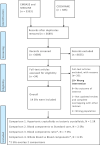Volume replacement in the resuscitation of trauma patients with acute hemorrhage: an umbrella review
- PMID: 38036955
- PMCID: PMC10687916
- DOI: 10.1186/s12245-023-00563-4
Volume replacement in the resuscitation of trauma patients with acute hemorrhage: an umbrella review
Abstract
Background: The use of intravenous fluid therapy in patients with major trauma in prehospital settings is still controversial. We conducted an umbrella review to evaluate which is the best volume expansion in the resuscitation of a hemorrhagic shock to support the development of major trauma guideline recommendations.
Methods: We searched PubMed, Embase, and CENTRAL up to September 2022 for systematic reviews (SRs) investigating the use of volume expansion fluid on mortality and/or survival. Quality assessment was performed using AMSTAR 2 and the Certainty of the evidence was assessed with the Grading of Recommendations Assessment, Development, and Evaluation (GRADE) approach.
Results: We included 14 SRs investigating the effects on mortality with the comparisons: use of crystalloids, blood components, and whole blood. Most SRs were judged as critically low with slight overlapping of primary studies and high consistency of results. For crystalloids, inconsistent evidence of effectiveness in 28- to 30-day survival (primary endpoint) was found for the hypertonic saline/dextran group compared with isotonic fluid solutions with moderate certainty of evidence. Pre-hospital blood component infusion seems to reduce mortality, however, as the certainty of evidence ranges from very low to moderate, we are unable to provide evidence to support or reject its use. The blood component ratio was in favor of higher ratios among all comparisons considered with moderate to very low certainty of evidence. Results about the effects of whole blood are very uncertain due to limited and heterogeneous interventions in studies included in SRs.
Conclusion: Hypertonic crystalloid use did not result in superior 28- to 30-day survival. Increasing evidence supports the scientific rationale for early use of high-ratio blood components, but their use requires careful consideration. Preliminary evidence is very uncertain about the effects of whole blood and further high-quality studies are required.
Keywords: Emergency treatment; Fluid therapy; GRADE approach; Major trauma; Systematic review.
© 2023. The Author(s).
Conflict of interest statement
The authors declare no competing interests.
Figures
References
LinkOut - more resources
Full Text Sources



